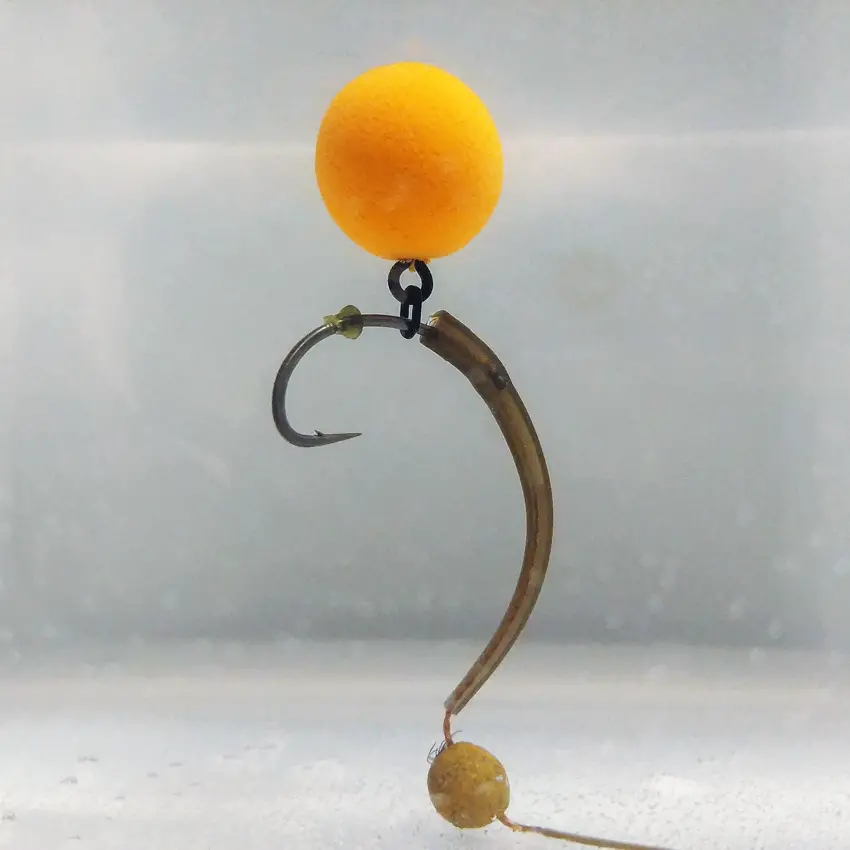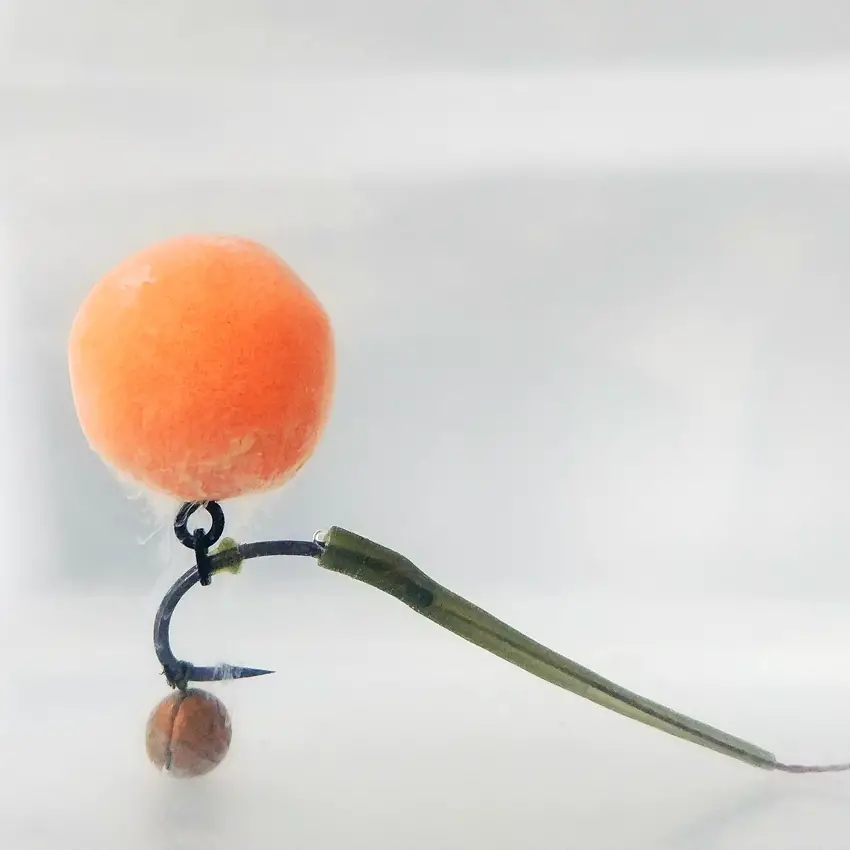The Withy Pool Rig

British fishing icon Steve Reynard invented this brilliant rig over thirty years ago.
The concept is simple: a rig that is almost impossible to eject once its in a fish’s mouth. Withy Pool was the name of rather tricky water in Bedfordshire, UK. Raynard was challenged with trying to determine a way to trip up some incredibly wary fish. The Withy Pool Rig was the product of many nights of strenuous thought.
The rig is simple and is considered by many to be one of the best, if not THE best pop-up rig ever conceived. Reynard’s concept proved to be effective, landing him some of the most elusive specimens in the lake.
The rig is tied using a stripped back-length of semi-stiff coated braid, a curve-shank hook, a length of shrink tubing, bait-screw or rig-ring, a hook-stop, and a split-shot or dab of tungsten putty. The hook is tied to the coated braid using one’s preferred knot. Then, the shrink tubing is cut to fit just over the hook’s eye to the break in the braid’s coating.
The shrink tubing is then heated using a kettle. While it’s still hot and malleable, it’s formed into a “C” shape (the aggression of the bend is up to the angler, but it is important to be mindful to not close the gap too tightly). Once the shrink tubing cools, it will retain this shape, making for a highly responsive rig (more on this in a moment).
Finish it off with the bait-screw or rig-ring, hook-stop, and your chosen split shot or tungsten putty to offset the buoyancy of the bait, and you have a proven Carp-catcher.
A Highly Responsive Rig
What did I mean by responsive? Upon attaching a pop-up to that rig and submerging it, the answer should become clear: This rig will turn in any direction from which a Carp could pick it up. And once in its mouth, it has a near one-hundred percent hook-up ratio.
The Withy Pool has only really been a part of my arsenal for the past year, so my experience is limited, but I have played with it. Before using the Withy Pool, I was a big fan of the Hinged Stiff Rig, which is mechanically similar. Both of these rigs function with the same concept—that a longer, stiffer material attached to the hook mimics the hooking properties of a long-shank hook, without needing to add additional weight.
The Withy Pool Rig makes its way into my top five favourites for this reason: it is made using a single length of braid (rather than a braid and fluorocarbon combination). Though many would argue that a well-tied Hinged Stiff rig is just as effective as a Withy Pool, the fact remains that the more knots and components present, the higher the potential for rig failure.
The Withy Pool took priority in my angling last year, catching me the majority of my fish in almost every condition imaginable: gravel, low-lying weeds, silt, and decayed leaf matter. In fact, with the possible exception of incredibly dense, deep weed mats, the Withy Pool can be fished anywhere. I highly recommend this rig. Seriously—get tying!
The Shotshank Rig

Those of you that know me personally will know that I often boast about the Spotshank Rig. The concept isn’t original but is, in fact, a combination of two ideas—which I am proud to say I combined.
The first (and most obvious) concept is the presence of a split-shot affixed to a tiny piece of braid, which is then fastened in place by burning and blobbing the braid with a lighter. This rig, initially created by Frank Warwick, is known as the Shot-on-the-Hook Rig (which doesn’t exactly roll off the tongue).
Carp Vacuum
One must imagine that a Carp creates a vacuum when taking the bait or rig into their mouth. Once this vacuum-like atmosphere neutralizes, the rig drops as though it were falling through the water column again. So the rig will drop onto the bottom of a Carp’s mouth. The Shot-on-the-Hook Rig utilizes a heavier hook-point; the idea is when a Carp sucks in the rig, and the rig enters ‘free-fall’, the hook will be driven down by the weight and thus have excellent hooking potential.
A concern raised about this rig is the possibility of the split-shot impeding the hook’s ability to penetrate deep. However, those who have tried spooling a stainless steel spool with braid will know that braid slips on steel and requires a backing to prevent this. The same principle applies here: The split-shot will move up and out of the way if the hook points find a home—meaning the hooking potential of this rig is incredible.
When I first started experimenting with this rig, I found it tended to tangle on the cast. This was probably because the added weight on the hook exceeded the coated braid hook link’s stiffness. So, while descending to the bottom, there was a chance that the rig would collapse upon itself and potentially tangle or sit in an undesirable manner.
Kill Two Birds With One Stone
This led me to introduce a second concept that would essentially kill two birds with one stone: I would introduce the mechanics from Scott Lloyd’s Noodle Rig by adding a shrink tubing or longer hook-aligner to better balance the presentation. This forces the rig to kick out more effectively while increasing the hooking potential. The result is a more cumbersome rig to try and eject. Needless to say, this rig is an excellent feat of ingenuity.
Though I have not used this rig as shown in the photo, I have used both the Noodle Rig and the Shot-on-the-Hook Rig, and feel that the union of these two concepts will only mean the best of both worlds. The Shot-on-the-Hook Rig (and slight variations thereof) landed me a few fish last year and proved to have deep, sure hook-holds.
The Noodle Rig is essentially a Hair Rig variation with a notably longer hook-aligner, which I have experimented with in the past with great success. My Shotshank Rig was conceived during this past winter and has yet to see action. So you may be wondering why it has made the list. Well, in my studying of rig-mechanics, this rig checks off most—if not all—of the boxes.
I believe this rig will perform in practice as well as it does in theory. I recommend fishing this rig over clearer bottoms, dense silt, and anywhere you may fish a Ronnie/Spinner Rig.
In case you are wondering about the names mentioned above and the “Who’s Who” of the Carp world, then go here.
Parting Words

It is important when choosing a rig to be mindful of the water you’re fishing; some rigs work better in different applications. With practice and experience, it becomes easier to choose the right rig for the water. I also recommend that you consider the stock of fish you are pursuing.
If you have a large population of big fish or are fishing in particularly snaggy or zebra-mussely waters, consider using more robust materials in twenty-plus-pound breaking strain.
While on the topic of rig materials, consider purchasing coated braid; this is ideal for tying coarse fishing rigs, and you will have a great deal more confidence that your rigs are presented as intended.
When I used to tie Hair Rigs using the same braid I would spool my reels with, I found that my rigs were far more likely to tangle. Once I switched to coated braids, I discovered that this problem was alleviated. The rigs both presented better and caught more Carp.
Final Advice
A few final pieces of advice: Go with what you feel confident in; there’s no point in using a rig with which you have no confidence. So practice tying a variety of rigs so you can be sure your presentation is as intended.
Additionally, don’t be afraid to try new waters, even if they might be weedy! Here in North America, our Carp see little angling pressure, and some might even call them a bit naive; so you’ll often find yourself using simple rigs on clear lake/river beds without a problem. But it’s always important to try new things and explore new areas. We are truly fortunate to have the opportunity to target such hard-fighting fish here in Ontario.
So get out there, try out some of these Carp rigs, and make the most of this exciting species!
Tight Lines
